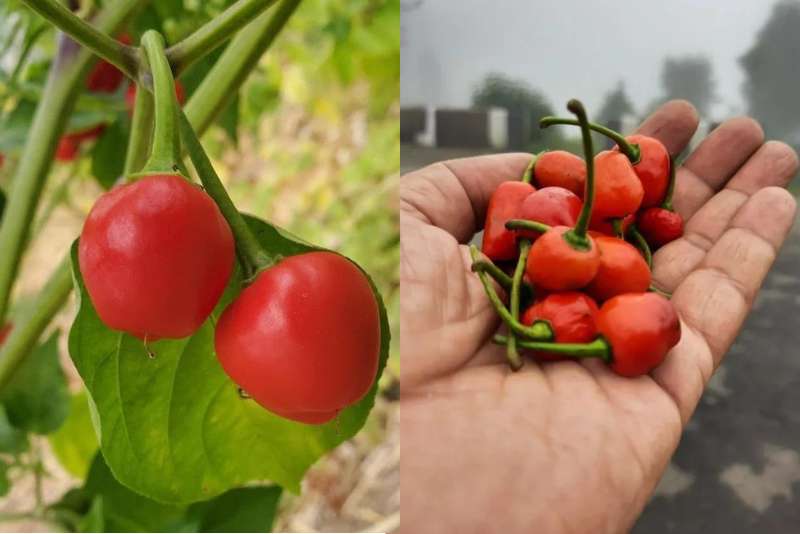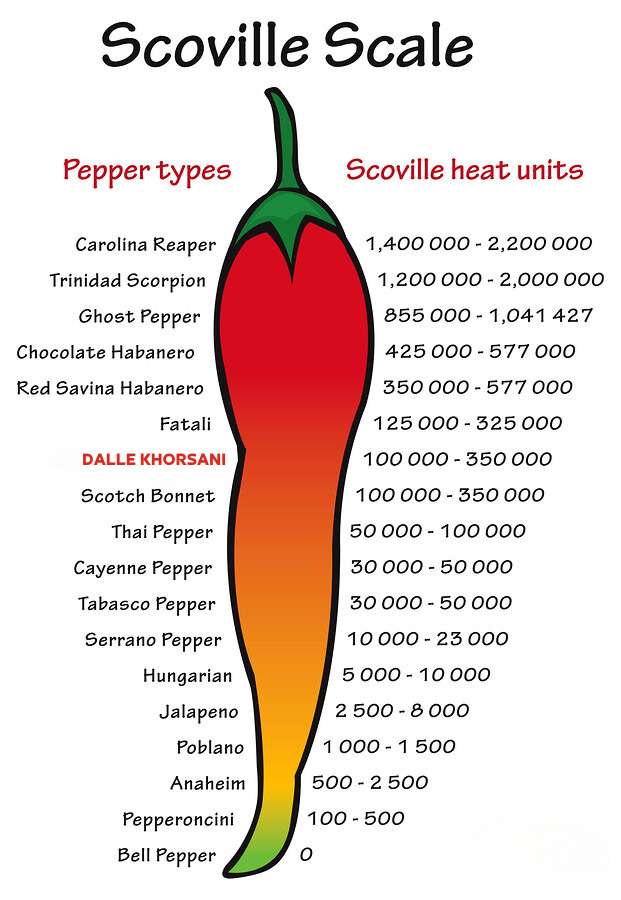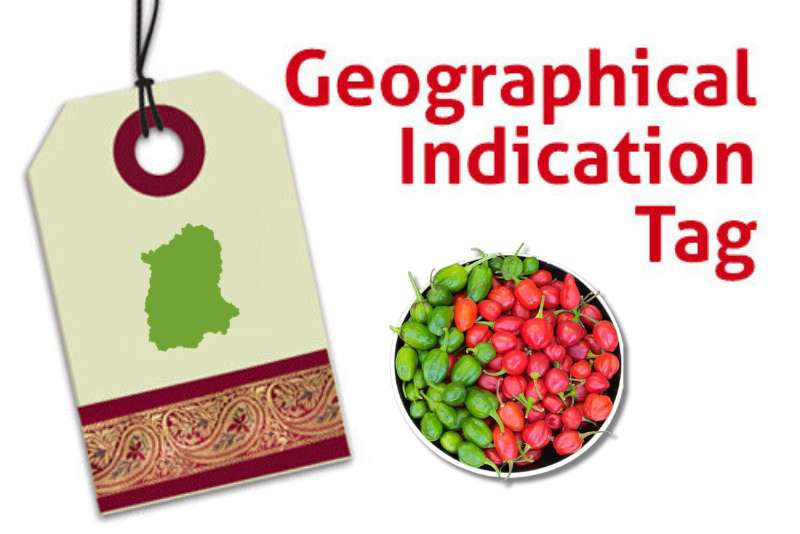
In the lush hills of Sikkim, a hidden treasure thrives – the Dalle Khorsani. This red cherry pepper, scientifically known as Capsicum annuum var. cerasiforme, has etched its name in the annals of culinary delight. Known for its unparalleled taste, distinctive flavor, and fiery pungency, Dalle Khorsani has become a culinary sensation that transcends borders. In this article, we delve into the secrets of this extraordinary chili, its cultivation, and its journey from local delicacy to global fame.
Unveiling Dalle Khorsani
Cultivation and Geographic Indication (GI) Tag: Dalle Khorsani is predominantly cultivated in the mid hills of South, West, and East Districts of Sikkim, extending into the Darjeeling district of West Bengal. The journey of commercial cultivation began in 1996 when Mr. Nanda Lall Dawari sowed the first seeds in Namphok, South Sikkim, with just around 600 saplings. Since then, it has thrived, and now, tourists from across the world seek it as the “Gift of Sikkim.”
Botanical Insights: Dalle Khorsani belongs to the Solanaceae family and the Capsicum genus. It can reach heights of 100 to 130 cm in open fields and 150 to 180 cm in greenhouses, yielding 2.5 to 3.0 kg of fruits per plant, with approximately 500 to 1000 pods. Remarkably, this chili can be cultivated year-round under protected conditions. On the Scoville scale, which measures spiciness or heat, Dalle Khorsani scores between 100,000 to 350,000 Scoville Heat Units (SHU).

Commercial Value: Dalle Khorsani has evolved into a valuable cash crop for Sikkim, thanks to its diverse commercial applications. The bright red, fully ripe fruits are coveted for pickles, sauces, and paste making. Processing of Dalle Khorsani started in Rabongla in 1998 under the brand name “High Altitude” by Mr. Samir Tamhane. Later, the government food preservation factory, “Sikkim Supreme,” in Singtam East Sikkim, began production in 2000. The year 2007 saw the establishment of “Sikkim Greengrocer” in Lower Sichey, Gangtok, specializing in dalle chili pickles and paste. Dalle’s popularity surged, both nationally and internationally. In 2015, M/s. Greengrocer introduced “Peero,” a Dalle Khorsani sauce with global recognition.
Global Recognition and Challenges: Dalle Khorsani’s fame even reached the shores of the United States when the 180-year-old American company Tabasco raised legal concerns over product design copyright issues. Fortunately, these issues were resolved, further cementing Dalle Khorsani’s global presence.
The Geographical Indication (GI) Triumph

Recently, the World Trade Organization bestowed a Geographical Indication Tag upon Dalle Khorsani, a source of immense pride for Sikkimese farmers. This GI recognition safeguards the chili’s unique identity, preventing unauthorized use of the name and ensuring that only chilies grown in the designated region bear the prestigious Dalle Khorsani label.
Beyond Heat: Health Benefits of Dalle Khorsani
Beyond its fiery spiciness, Dalle Khorsani boasts various health benefits. It contains Capsaicin, which not only contributes to its pungency but also offers medicinal properties. Carotenoids and phenolic compounds found in Dalle Khorsani serve as natural pigments and antioxidants. While the Scoville scale reveals its high pungency, Dalle Khorsani is rich in vitamin A, vitamin E, and potassium while being low in sodium. Vitamin E content, at 240 mg per 100 grams of fresh Dalle Khorsani, makes it a particularly valuable nutritional resource.
Pepper, in general, is renowned for its health-enhancing properties. It can clear the lungs and sinuses, protect the stomach by stimulating the flow of digestive juices, and trigger the release of endorphins, the body’s natural painkillers. Additionally, it can stimulate saliva production, neutralizing cavity-causing acids, and offers protection against cancer through its antioxidant activities. Prominent figures like Swami Ram Devji and Acharya BalKrishnaji have been advocating the health benefits of Dalle Khorsani on various TV programs, foreshadowing a promising future for this chili. Patanjali, a well-known brand, has also entered the Dalle Khorsani market, launching pickles and sauces under the “HOT Hill” brand for its stores.
Cultivating Dalle Khorsani: A Guide
Soil and Climate
Red cherry peppers thrive in warm and humid climates. They can tolerate high temperatures but are sensitive to heavy rain during growth, flowering, and fruit set. Extremely cold weather, below 12°C during the night, can also hinder growth and fruit set. Ideal temperatures for flowering range from 20-25°C. Dalle Khorsani can adapt to various altitudes and soil types, but sandy loam soil with a pH of 5.5 to 7.5 is optimal. Soil with poor drainage can be reclaimed using limestone or dolomite.
Land Preparation
Proper land preparation is crucial. The main field should be plowed 3-4 times to achieve fine tilth, with the incorporation of farmyard manure during the last plowing. Cow urine can also be used for soil drenching to prepare the soil adequately.
Nursery Management
For optimal results, choose an elevated site near the planting area that receives ample sunlight and is close to a water source with well-drained land. Nurseries can be set up under protective structures like polyhouses or net houses. Prepare the nursery bed with a mixture of farmyard manure, neem cake, and vermicompost. Maintain a bed size of 1m x 1m, leaving space for central and inter-bed paths for intercultural operations. Mulching with dry leaves, paddy straw, or black polythene promotes early germination. Regular weeding and watering are essential, with a focus on managing common diseases like damping off.
Transplanting and Planting
Seedlings are typically ready for transplanting at 30-35 days old. Prior to transplanting, it’s advisable to expose seedlings to open conditions for a day. Transplanting should be carried out in the afternoon. Dalle Khorsani can be grown year-round under protected conditions, with preferences for warm, humid climates during early stages and drier weather as pods mature. Spacing at 1m x 1m on raised beds is ideal to prevent water stagnation, which can harm the crop.
Nutrient Management
Nutrient management relies on organic sources, incorporating nutrient-rich manures and growth promoters. Recommended manures and bio-fertilizers for Dalle Khorsani include farmyard manure, neem cake, Azospirillum PSB, vermicompost, bio NPK, boron, and Miraculon. These should be applied at specific doses and times according to the plant’s growth stages.
Intercultural Operations
To ensure a healthy Dalle Khorsani crop, manual weeding is necessary. Gap filling should be performed during the second irrigation, approximately 10 days after transplanting. Light hoeing helps control weeds and maintains proper aeration and root growth. To encourage vegetative growth, fruit set, and yield, it’s advisable to pinch off buds from the first and second nodes. In cooler seasons, especially when sunscald is not a concern, unproductive branches below the first nodes can be clipped. As Dalle Khorsani plants grow tall, staking is essential to prevent lodging due to the weight of the fruit. Earthing up the plots should also be done 30-45 days after planting. For mulching, options include dried leaves, paddy straw, sawdust, or black polythene sheets, with the latter being the most preferred choice for this crop.
Irrigation Maintaining a consistent and optimal water supply is critical for Dalle Khorsani’s growth and fruit yield. The first irrigation should be carried out immediately after transplanting, followed by weekly intervals. Care should be taken to avoid heavy irrigation, as it can lead to soil-borne diseases like wilt and collar rot.
Plant Protection Dalle Khorsani faces threats from aphids, known locally as Lye Kira. These pests not only sap the plant’s vitality but also secrete honeydew, attracting ants and fostering sooty mold growth on the leaves. Aphids can also serve as vectors for viral diseases. To combat this, the application of systemic bio-pesticides such as Verticillium lecanii or petroleum-based oil sprays (6 ml/liter) is recommended. Another concern is fruit flies that lay eggs in the fruits, leading to fruit drop. Address this issue by placing 8-12 pheromone traps per hectare during fruit set and promptly collecting and disposing of fallen fruits.
Harvesting Dalle Khorsani plants typically start flowering 70-80 days after planting, with the first picking carried out at the ripening stage. These plants continue to bear fruits for 2-3 years. When harvesting, gently lift the fruits from the plant to avoid injury or stem breakage. Dalle Khorsani is a sensitive crop that must be processed within a week; otherwise, it can be dried in the sun and used as chili powder.
The Promising Future of Dalle Khorsani
Dalle Khorsani is not just a fiery chili; it represents a rich cultural heritage, agricultural innovation, and a path to a healthier lifestyle. With its newfound recognition through the GI tag and increasing global interest, Dalle Khorsani’s future looks brighter than ever. It is poised to become more than just a spice; it is a symbol of Sikkim’s resilience, culinary excellence, and the potential to impact the world positively.
In summary, Dalle Khorsani is not merely a chili; it is a testament to the synergy between nature and human ingenuity, a fiery jewel from the heart of the Himalayas. As it continues to captivate taste buds and gain recognition on the global stage, the world awaits the next chapter in the remarkable journey of Dalle Khorsani.
Gangtokian Web Team
















































